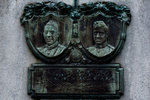
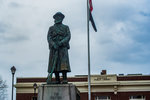
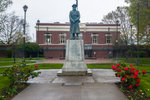
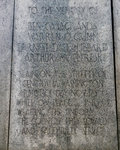
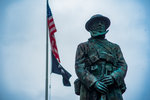
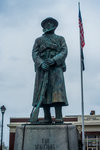
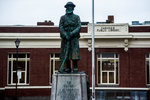
Efforts by an informal committee of community members to mark the centennial anniversary of the Centralia Armistice Day Tragedy have hit a number of snags ranging from dwindling membership to infighting over the location and text of a proposed monument meant as a counterweight to The Sentinel statue in Washington Park.
Core members of the group said they remain committed to finding ways to recognize the tragedy, also known as the Centralia Massacre, this fall. Six men were killed during the conflict between members of the American Legion and the Industrial Workers of the World, which was followed by a controversial trial that caught the attention of the nation.
Attendance at the monthly committee meetings has dwindled to single digits from a high of about two dozen. Teva Youngblood, who began the endeavor in 2018, stepped down from her leadership post earlier this year and it is unclear who will take charge as time becomes more a factor.
“I’m stymied and mystified as to what it’s going to take to make this work,” said Peter Lahmann, a lifetime resident of Centralia who joined the group primarily as a representative of the Thurston-Lewis-Mason Central Labor Council. “People want consensus on this, but this is not the kind of issue that breeds consensus. I can’t foresee that we’ll ever have a consensus, because this is still a very tender topic.”
The deepest divisions between committee members have to do with proposals for the wording of a monument the group wants to erect in Washington Park near The Sentinel, a statue in front of the Centralia Timberland Library installed long ago in remembrance of the four Legionnaires killed during the riot of Nov. 11, 1919.
Jay Hupp, a native of Centralia who lives in Shelton, joined the committee in November and worked with other members to script the text for the monument in such a way as “to get a little better understanding of the other side of the issue, so that there’s an opportunity for a more balanced view,” he said.
According to Hupp, their text went through about half a dozen revisions leading up to the January committee meeting, where representatives from the IWW came with a proposal listing the names of the eight men convicted of murdering the Legionnaires, Everett, and attorney Elmer Smith.
The monument proposed by the IWW would also include its logo and have more forceful language rebutting that of the Sentinel, including a description of the eight men being “unjustly imprisoned.” That was the meeting with more than two dozen attendees, many of whom had not been to one prior to that night.
Messages left with the Olympia chapter of the IWW were not returned prior to press time. A blog post on its website dated March 13 includes an illustrated image of Wesley Everett, an IWW member who was lynched in the aftermath of the riot, hanging by his neck above the logos of the IWW and the American Legion.
“It appeared to me like an intentional overloading of the committee that night to vote on one inscription as opposed to the other,” Hupp said. “That really is the essence of the friction.”
This led to an April 2 column in The Chronicle by Julie McDonald accusing Lahmann and Hupp of ignoring the vote in favor of the IWW language and of asking Centralia city officials to approve a monument with their wording, which states the IWW members opened fire in self-defense.
“I hate wasting time, but that’s what more than a dozen people did in January at a Centralia Armistice Day Committee meeting,” McDonald’s column begins. “…Talk about a total lack of respect for others — and the democratic process. So much for a united attempt to commemorate a 100-year-old tragedy that left no winners anywhere.”
Lahmann and Max Vogt, Mayor Pro-tem of Centralia and member of the committee, said there has yet to be an application filed with the city and that any addition to a public park would require approval by the city council. Hupp, who wrote a letter to the editor responding to McDonald’s column, characterized it as a hit piece.
Esther Barnett Goffinet, a resident of Lewiston, Idaho, and daughter of one of the IWW members imprisoned following the tragedy, gave her blessing to Lahmann and Hupp. She wrote a letter to the editor stating historical texts about the tragedy are largely one-sided in favor of the Legionnaires and that her book, “Ripples of a Lie,” contains a truthful version of events.
“There are other people who are very much interested in what happens with this project that are not necessarily visible at this point,” Hupp said. “There’s family members and descendants on both sides of the issue, there are union issues between the IWW and other organized labor. I don’t know that I have an answer or a projected outcome of where this might go. To say how this thing is going to pan out, I don’t think anyone can predict it at this point.”
Vogt remains optimistic that between the remaining people who show up to each committee meeting — anyone can attend the public gatherings, the next of which is at 5 p.m. on Monday at the Centralia Timberland Library — along with city input when appropriate will produce some sort of commemoration on Nov. 11 that is directed at acknowledging old wounds and examining the lessons of a day when lives were lost.
“As people have peeled off and the group has gotten smaller, it seems like it’s been more people who are heavily invested in what happened,” Vogt said. “If more people come, I think it’s obviously better. There’s no officially designated group other than those who just want to show up and work out an agreement.”
That any language would have to pass muster with the council gives Vogt and Hupp some level of optimism, because the two sides would need to agree on something they thought could get approval from the city before submitting the paperwork.
Lahmann is adamant that any commemorative event on Nov. 11 not conflict with the annual American Legion proceedings marking Armistice Day in Centralia. All are aware that as they seek to repair fissures within their own ranks, time is running out for anyone to see their hopes come to fruition.
“If we decide there’s going to be a monument dedication that day, it takes awhile for the company to make it and to raise funds to pay for it,” Lahmann said. “So you’re backing up and and backing up into a tight timeline. I don’t think the committee is a waste of time, as has been said. But someone has to take it on and make some decisions.”